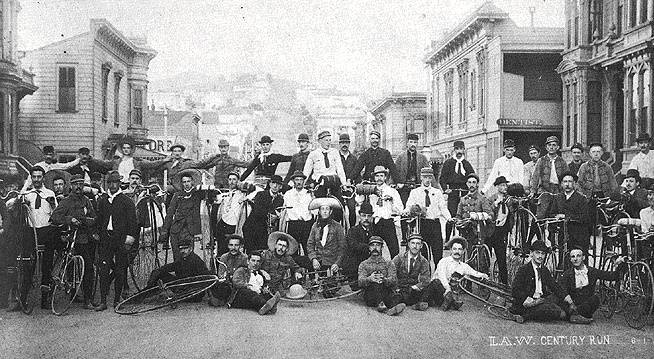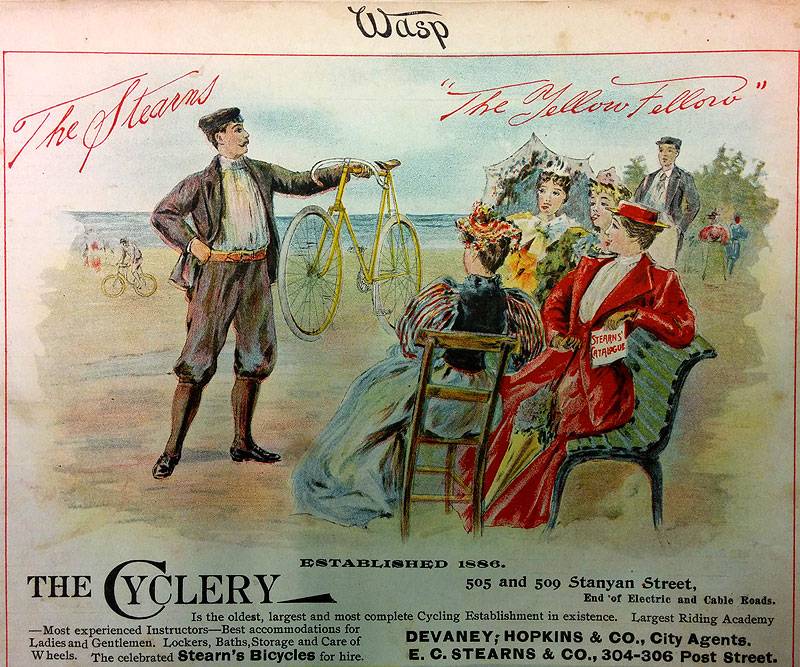CYCLERS RIDE IN GAY ATTIRE
Primary Source
from the San Francisco Call, 10/6/1896
Bay City Wheelmen at the outset of a Century (100-mile) Ride in 1890 on 21st Street, probably at Folsom.
Photo: California Historical Society
Amid red fire, bombs, rockets and music, the cyclers of San Francisco had their display last evening in favor of good roads. There was a good number of those who love to ride on pneumatic tires, and the Parade was witnessed by thousands, who lined to streets through which the procession passed.
The cyclers were enthusiastic, and on many points along the line they were loudly cheered, and in response to the cheers came the cry of the various clubs, which often drowned the sounds of the music in the band wagon. As an earnest of a desire for good roads the parade, in which there were more than a thousand participants was a success.
By the time darkness spread over the City the hall of the Olympic Club on Post Street was a scene of great activity. There was a rushing to and fro of those members of the organization who belonged to the cycling section, getting ready for the event. There was the dressing of wheels, the fixing of lanterns of various hues, flags and colored bunting, flowers and ribbons to make silent steeds gandy and attractive. And every now and then there came from the inner rooms participants in riding attire, some plain, some gorgeous, some comic and many grotesque. Some of the young men appeared as the new woman and as the bloomer girl, while others, who seemed to carry out the character to life, appeared as clowns.
While this rush and excitement was going on in the big building there was an unusual, commotion on Post Street, from Taylor down to Grant Ave. There was a gathering of people on the walks anxious to see the start, and collections of cyclers on the cross streets, singly, in pairs and by clubs, riding to the various points assigned them by the marshal of the night. Then came the band wagons and the floats and the fireworks wagons. Then in a short time there was a lighting up of lanterns and the burning of red and white fire, which illuminated to scene and presented to the onlookers a gay and festive picture that resembled some grand carnival. The gayly trimmed bicycles and the vari-colored uniforms of the riders were brought out in full effect by these strong lights.
Sharply at half past 8 o'clock Marshal Edwin Mobrig gave the order to fall in and follow the bandwagon, and to the air of Sousa's "Liberty march" the procession moved on. After the mounted police came the Alpha (ladies) Cycling Club, the Olympics Cyclers, visitors on wheels from San Rafael, San Jose, Oakland, Alameda and Berkeley, the Reliance Athletic Club, Acme Club, Camera Club Cyclers, Waverlys, Pathfinders, Liberty Club, Golden Gate Cyclists, Yellow Fellow Club, Yosemite and Eintracht Club, Imperial Club, Union Iron Works Wheelers, Ramblers, Columbias, Bay City Wheelmen, Barker Cyclers, and many independent wheelmen.
There were a number of attractive features in line, the most prominent of which was a large float prepared by the Olympics. It was a representation of a Roman gladiator (George Miehling) extending the hand of fellowship to the modern cycler (Allen Jones).
The Pathfinders had in line an imitation prairie schooner such as was used to cross the plains in early days, and labeled the "John C. Fremont Pathfinder of '46." The purpose of this was to find a good path for cyclers in the City.
The Olympics carried a transparency bearing the words, "A clean sweep at the polls means a clean sweep for our wheels." Charles H. Northrop made up as a Rip Van Winkle, and independent cycler, attired in a paper suit, carried a banner with this strange device, "Journalism up to date."
The Golden Gate Club had a float on double quad representing a Golden Gate, festooned with flowers and hung with many lanterns. The Yosemite and Eintracht Clubs were all attired as red devils, with fierce painted faces.
The Imperial Club turned out an immense elephant mounted on a double quad and on this was a placard with the words: "Don't Tease the Animals -- S. P.C. A." F. Murphy, also of the Imperials, represented Uncle Sam riding a bicycle with many McKinley emblems. The Ramblers had a triplet written by three pretty children, Eva, Maude and Walter Varney. This club of also had out a gayly decorated sextuplet made up of three tandems fastened side-by-side.
"His Whiskers" was out on a bike, and there were bets of even money that it was Judge Campbell. It was left for the judges to decide. J. R. Rogers of the Imperials rode a bike to which he had hitched two bull pups that dragged him along at a lively rate. The last float is line was that of the San Francisco Road Club, representing the Pony Express, a pretty arrangement. There were several children in Continental costumes, two pages in full silver suits, Indians, colored and Chinese cyclers, monkeys on wheels and many riders in fantastic garb. There was in line a number of cyclers fitted up as boats with full sail. One of these was marked "C. P. Huntington." Another was labeled "Opposition ferry." Still another, in imitation of a flatcar, had a streamer on which was painted "This train carries bicycles free." Still another design on wheels on which there was a coffin bore these words, "Killed by riding a wheel over the Market Street pavement."
The mounted police had a great deal of difficulty on Market Street in keeping the crowd back far enough to enable the paraders to proceed. As soon as the officers drove back one section of people and rode on the crowd pressed forward and in that way interfered with the paraders. On the line of march a number of the wheels broke down and had to be withdrawn, but none of the riders were injured. At several points along the line there were displays of red fire and from several points fireworks were set off.
Along the line of march on Golden Gate Ave., from Market Street as far out as Van Ness Ave., the sidewalks were crowded with spectators and every house was alight, with windows open so that those inside could see the interesting spectacle. The steps leading to every door were tiers of people. Beyond Van Ness Ave. the crowds extended on both sides of Golden Gate Ave. as far as Webster Street, nor was it any thinner along Fulton Street, the line of return march. On Van Ness Ave., between Golden Gate Ave. and Hayes Street, there was an immense throng, which kept the policemen busy confining it within the proper limits, which were all too small.
The various bicycle clubhouses were decorated with Japanese lanterns, flags and bunting, and some private dwellings on Golden Gate Ave. were similarly illuminated in sympathy with the wheelmen and their movement. The clubs contributed liberally of red fire and rockets and Roman candles to brighten the wheelmen's way, and, as it were, to express their enthusiasm over the grand display.
It was a long, expectant wait that the spectators had out in the limited district of good roads where the two avenues cross, but when the first rocket burst high above them in the night a chorus of approving exclamations made it plain that everybody was happy and pleased with a rest in the cool evening air. And then in a very short time, it seemed, another murmur and a stir followed. "Here they come!" was upon every one's lips.
They came, the fantastic glittering phalanx of wheelmen in carnival array with music and red fire. They came, and they passed like colors and forms in the kaleidoscope, leaving an impression of something beautiful and altogether odd. Out on the smooth pavement the bicyclists could preserve good lines, and for that reason the pageant was more to be admired on Golden Gate Ave. than when the wheelmen struggled painfully uphill and downgrade along the rough pavement on Market Street. The last of the procession had barely gone out of sight when its head turned from Fulton Street into the grand, broad Ave., there to be reviewed by the judges: Mrs. A. L. C. Barnes, Mrs. N. A. Robinson, S. H. Bushnell, W. R. Wheeler, Charles G. Sparrowe, George H. Davis, James S. Devlin, John Scott, John H. Dawson, C. O. Perry, J. H. Brunings and R.C. Lennie.
There was considerable confusion at the judge's stand, caused by the paraders themselves breaking ranks immediately after passing and then blocking the way. With the aid of several policemen Dr. Rottanzi succeeded in opening a passage and the procession again moved through in poor order with nearly every cyclist afoot and elbowing for room. It was generally conceded that the most tastefully decorated and most artistic wheel was the tandem of Mr. And Mrs. G. B. Ludlow (No. 31), a really beautiful affect in colors, flowers and rich Oriental lanterns. Ms. Alice Guthrie (No. 1), a pretty little tot in white under a floral canopy, was noticed favorably.
Miss Minnie Huff (No. 15), as a page from the Huguenots, did considerable attention for her original graceful decoration. Miss Lotta Crenshaw (No. 55) as the "Examiner" in white satin and silver appeared conspicuous for her beautiful costume. Miss Lottie Britton (No. 16) was unique as Amelia Bloomer on a child's velocipede. No. 35 Little Red Riding Hood, in the person of Miss Laurine DeVaney, won applause and probably a prize. The yacht-rider (No. 11) was Joseph Clunan. C. F. Harrison (No. 70) as the "Tough Girl" received a favorable notice. The "Golden Gate" tandem (No. 82), George Hale and Al Lewis, was one of the most picturesque ideas well carried out, and the Chinese laundry (No. 67) presented by N. Cohn, was taken as an odd conceit. The two Mohnig children (No. 64) on a tandem made a very good showing. The Olympics may expect to hear from their double tandem float with the little daughter of William Kennedy enthroned on it.
There was so much to consider, so much in variety, novelty, originality and taste that the judges were compelled to reserve their decisions until today.
The Cyclery, a bicycling business along the Stanyan Street east end of Golden Gate Park, since 1886, according to this ad that appeared in The Wasp.
Image: California Historical Society


